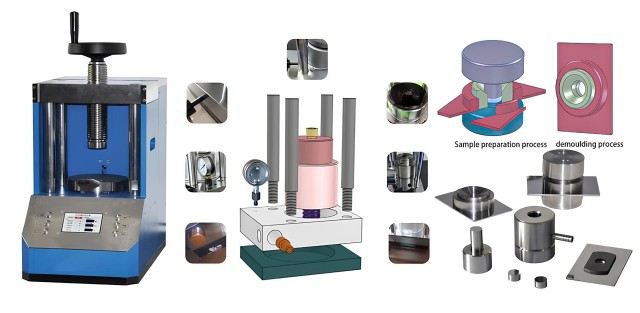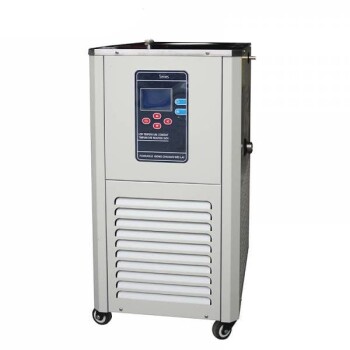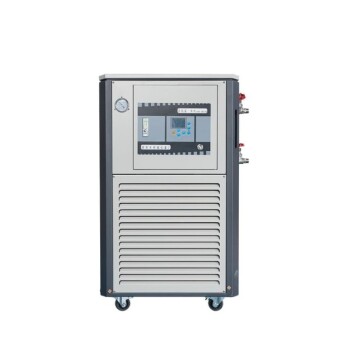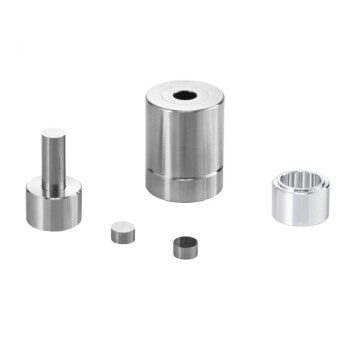Introduction
Table of Contents
- Introduction
- Basic Elements and Sample Preparation
- Key Features of Laboratory Press
- 1. Mechanical structure with 4 columns and sliding platen
- 2. Hydraulic system with 25 tons closure force
- 3. 250x250 mm chrome plated steel platens with 40 mm thickness
- 4. Specifically designed flat heating elements for uniform temperature distribution
- 5. Closed moulding area for easy fume aspiration
- 6. Protection doors with safety lock
- 7. CE Labelling
- Automatic Press Control Details
- Cooling System
- Closure Force Control
- Moulds
- KinTek Press Logger
- Standard Calibration Service for Laboratory Press
- Conclusion
Laboratory presses are essential equipment in various industries, offering precise and controlled sample preparation for testing and research purposes. These presses come with a range of features and functions that ensure reliable and consistent results. Understanding the capabilities of laboratory presses is crucial for businesses looking to optimize their sample preparation processes. From uniform temperature distribution to mechanical solidity, these presses offer a comprehensive solution for consistent sample thickness and closure force. In this article, we will explore the key features, automatic press control details, cooling systems, closure force control, available molds, and the KinTek Press Logger for monitoring press conditions. Let's dive in!
Basic Elements and Sample Preparation
In order to achieve accurate and reproducible results in X-ray fluorescence (XRF) analysis, proper sample preparation is crucial. Whether you are working with loose or pressed powders, fused beads, solid samples, or liquids, finding the right approach to sample preparation is the first and most important step.

Uniform temperature distribution over the platen surface
One of the basic elements of sample preparation is ensuring a uniform temperature distribution over the platen surface. This is important because it helps to prevent any variations in temperature that could affect the analysis. By maintaining a consistent temperature, you can ensure that the samples are being analyzed under the same conditions, leading to more accurate and reliable results.
Mechanical solidity for constant thickness of the sample and consistent closure force
Another essential element of sample preparation is mechanical solidity. This refers to the solidity of the sample and its ability to maintain a constant thickness and consistent closure force. By ensuring mechanical solidity, you can eliminate any variations in sample thickness or closure force, which could introduce errors or inconsistencies in the analysis.
By using a tablet press, the ground sample is pressed into a sample that conforms to the analysis. There are both manual and automatic sample presses available. Manual presses are time-consuming and labor-intensive, and are rarely used in factories. Automatic presses, on the other hand, are increasingly used as they can be preset for pressure and holding time, saving effort and ensuring consistent pressed sample conditions.
The choice of press is based on two considerations: the maximum working pressure and the press die. The maximum pressure of the press should generally be no less than 30 tonnes to allow for a certain margin. Press sample molds are available in various materials, such as plastic rings, boric acid or low pressure polyethylene powder, steel rings, and others.
Good sample preparation is essential for achieving high-quality chemical analysis using XRF. It greatly increases the accuracy and reproducibility of the analytical results. XRF analysis does not require extensive sample preparation work and the methods used are inexpensive, straightforward, fast, easy to learn, and automated. This allows the operator to perform other valuable tasks in the laboratory.
Even for largely flat samples, surface finish can affect the analysis, especially for lighter elements. Rough surfaces can cause scattering and re-absorption of longer wavelength elements. To achieve quantitative analysis of solid samples, it is often necessary to finish the surface with a lathe or grinding paper. The finer the finish, the better the results will be for the lightest elements.
It is important to note that the sample preparation method chosen should be applied to both the calibration standards and the unknown samples. This ensures consistency and accuracy in the analysis.
In conclusion, proper sample preparation is crucial for achieving accurate and reproducible results in XRF analysis. Uniform temperature distribution over the platen surface and mechanical solidity to ensure constant thickness of the sample and consistent closure force are basic elements to ensure reliable and high-quality analysis. By following the recommended sample preparation methods, you can optimize your XRF analysis and obtain accurate and meaningful results.
Key Features of Laboratory Press
Laboratory presses are essential tools in various industries such as pharmaceutical, laminating, rubber, and plastic molding. They are widely used in research and development work, testing, short runs, limited production, cell manufacturing, and lean manufacturing. The key features of laboratory presses include:

1. Mechanical structure with 4 columns and sliding platen
Laboratory presses are built with a robust mechanical structure that consists of 4 columns and a sliding platen. This design ensures stability and precision during the pressing process.
2. Hydraulic system with 25 tons closure force
The hydraulic system in a laboratory press provides a powerful 25 tons closure force. This force allows for effective compression and compaction of materials such as rubber, plastic, and laminate materials.
3. 250x250 mm chrome plated steel platens with 40 mm thickness
The platens of laboratory presses are made of chrome-plated steel with a thickness of 40 mm. This construction ensures durability and uniform pressure distribution during the pressing process.
4. Specifically designed flat heating elements for uniform temperature distribution
Laboratory presses are equipped with flat heating elements that are specifically designed to ensure uniform temperature distribution over the platen surface. This feature is crucial for achieving consistent and high-quality results.
5. Closed moulding area for easy fume aspiration
To ensure a safe working environment, laboratory presses are designed with a closed moulding area. This feature allows for easy fume aspiration, ensuring the removal of potentially harmful gases or fumes.
6. Protection doors with safety lock
Laboratory presses come with protection doors that have safety locks. These safety features prevent accidental openings during the pressing process, ensuring the operator's safety.
7. CE Labelling
Laboratory presses are labeled with the CE mark, indicating that they comply with the European safety, health, and environmental protection standards.
Laboratory presses are highly valued for their precision, durability, and ability to meet rigorous demands. They are indispensable tools in research and industrial inquiries, providing consistent and reliable results. Whether it's for testing, compacting materials, or other applications, laboratory presses play a vital role in various industries.

Automatic Press Control Details
PLC controller with user-friendly Touch Screen Display
An operator interface is provided through an LCD touch-screen mounted in a control panel. An extensive range of standard displays is available. Often the operator will program and monitor furnace operation from the unit while the operation is supervised from a remote location during the cycle.
Each load has its own unique and often preprogrammed recipe to control such process variables as ramp rates (heating & cooling), preheat temperatures and times, final process temperature and time, ultimate vacuum level, partial pressure setpoints and quench gas pressure to name a few.
Free definition of the moulding cycle
The PLC controller for the press is provided with a user-friendly Touch Screen Display and permits the free definition of the moulding cycle by setting:
- The displacements of the moving platen of the press
- The thermal cycle (different temperatures of the platens and thermal gradients can be set within a moulding cycle)
- The pressure cycle (with the force control option installed)
Storage of three moulding cycles
Three Moulding cycles can be stored. Each cycle includes 24 moulding steps (including displacements, temperatures setups, and pressure setups)
Each cycle includes 24 moulding steps
Three Moulding cycles can be stored. Each cycle includes 24 moulding steps (including displacements, temperatures setups, and pressure setups)
Automatic hydraulic presses are often used for industrial XRF applications and other laboratory sample manipulation activities. However, their versatility makes them suitable for small and large-scale manufacturing practices, too – including hot embossing, laminating, and melting polymers for thin films.
The KinTek press can be equipped with a cooling device that allows the cooling of the platens at a controlled speed.
The Digital pressure regulation system is designed for applications that require an accurate control of closure force. A specific 2-stages hydraulic circuit, which includes proportional regulation valves and continuous fine regulation pumping system, has been designed to ensure accurate pressure control. The result is smooth and consistent force control which permits to set the closure force between 10 kN and 250 kN with 10 N set force regulation steps with regulation oscillations lower than 1000 N.
The control of the closing force is performed using the Automatic Press Control that must be installed in combination with the Closure Force Control option.
Moulds for producing plates and different types of samples according to international standards are available. Fixing rails with a sliding system permit easy handling of the molds. Molds produced upon customer design and company logo engraving are available on request.
The Automatic Press Control device is fitted with a USB port which permits the connection to a PC. The Gibitre Press Logger program permits the continuous recording of the press conditions (temperature, pressure, moving platen position, cycle step). Both graphical and numerical recording is provided with automatic generation of daily storage files. The program is compatible with Windows 10 and 11.
The service includes:
- Ordinary maintenance of the instrument
- Calibration of the temperature of the platens. The temperature is measured, with the plates closed, in 9 different points of the platens and at 3 different temperatures (140°C, 170°C, 200°C).
- Calibration of the closure Force (50, 100, 150, 250 kN)
Fully automated furnace operation controlled by PLC (Programmable Logic Controller) and IPC (Industrial PC-class computer). LCD touch screen visually displays all technological parameters of heat treatment processes. Large capacity of a hard disc (HDD) recording of unlimited number of recipes. It eliminates errors resulting from creating new recipes by a furnace operator. All process data are recorded and can be displayed as diagrams on a separate screen or saved on HDD or a CD. Export of historical data and alarm messages to external system for further analysis (e.g. to *.csv files). Easy integration with any database. The furnace is equipped with the internal Ethernet network; Remote furnace service is available through Internet or modem connection using dedicated software. Optionally the control system can be equipped with advanced batch reporting and history analyzing software which can present data using templates for standard MS Office applications, such as Word and Excel. A separate diagnostic screen reminds about maintenance requirements of individual components of the furnace. Energy efficient Power Management System to control heating and cooling capacity of the furnaces.
The speed, travel distance, and pressure of a press forging die are automatically controlled for accuracy and efficiency.
The forging press process has the same options as any other manufacturing method and can use CNC programming to enter designs, which can include blank feeding and forged piece removal.
Plastic deformation goes deep into the workpiece, creating a uniform deformation throughout the metal.
As with any form of manufacturing and production, safety is an initial concern. The positive side of press forging is that it does not require any form of special training for the operator except for concerns for safety.

Cooling System
Importance of cooling during the moulding cycle for thermoplastic materials
Proper cooling during the moulding cycle is crucial for thermoplastic materials. When thermoplastics are heated and injected into a mould, they take the shape of the mould cavity. However, in order to maintain that shape and prevent deformation, the material needs to be cooled and solidified before the mould is opened.
Cooling the material too quickly can result in internal stresses and shrinkage, leading to warping or cracking of the final product. On the other hand, inadequate cooling can result in incomplete solidification, leading to poor surface finish and dimensional accuracy.
Therefore, controlling the cooling process is essential to ensure the quality and integrity of the thermoplastic parts. By cooling the mould at the right rate and temperature, manufacturers can achieve optimal material properties, dimensional stability, and surface finish.
Optional cooling device for controlled speed cooling of the platens
In some cases, a cooling device can be added to the heated platen press to enable controlled speed cooling of the platens. This optional feature allows for more precise control over the cooling process, especially when working with heat-sensitive materials or when specific cooling rates are required.
The cooling device typically consists of a water cooling system that circulates cold water through channels in the platens. This helps to dissipate heat from the platens and accelerate the cooling process. By adjusting the water flow rate and temperature, manufacturers can achieve the desired cooling rate for their specific application.
The controlled speed cooling of the platens not only ensures the proper solidification of thermoplastic materials but also improves productivity by reducing cycle times. With faster cooling, manufacturers can increase their production output and meet the demands of their customers more efficiently.
Overall, the optional cooling device for controlled speed cooling of the platens provides manufacturers with greater flexibility and control over the moulding process, resulting in high-quality thermoplastic parts and improved productivity.
Closure Force Control
The closure force control feature in a filter press provides precise and accurate control over the pressure applied during the filtration process. This digital pressure regulation system ensures that the closure force is maintained within a specific range, allowing for optimal performance and consistent results.
Digital pressure regulation system for accurate control
The closure force control feature utilizes a digital pressure regulation system to ensure accurate control over the applied force. This system includes proportional regulation valves and a continuous fine regulation pumping system, which work together to maintain a consistent and precise pressure level.
Specific 2-stages hydraulic circuit
To achieve accurate pressure control, a specific 2-stages hydraulic circuit is implemented in the closure force control feature. This circuit includes proportional regulation valves and a continuous fine regulation pumping system. These components work together to regulate the pressure and maintain it within the desired range.
Smooth and consistent force control
The closure force control feature allows for smooth and consistent force control throughout the filtration process. By maintaining a consistent pressure level, this feature ensures that the filter press operates efficiently and produces reliable results.
Setting of closure force between 10 kN and 250 kN
With the closure force control feature, users have the flexibility to set the desired closure force within a range of 10 kN to 250 kN. This wide range allows for customization based on specific filtration requirements and ensures optimal performance.
In summary, the closure force control feature in a filter press provides accurate and precise control over the pressure applied during the filtration process. With its digital pressure regulation system and specific 2-stages hydraulic circuit, this feature ensures smooth and consistent force control, allowing users to set the closure force between 10 kN and 250 kN. By utilizing this feature, businesses can achieve reliable and efficient filtration results.
Moulds
Availability of moulds for producing various samples

When it comes to producing samples, having the right moulds is essential. Moulds are used in the compression molding process, where the stock material is placed in a mold cavity and compressed to create the desired shape. This process is commonly used in industries such as automotive, aerospace, and consumer goods manufacturing.
In the compression molding process, the mold is closed and maintained at a fixed temperature for a specific period of time. Under pressure and heat, the stock material flows and fills the cavity, with any excess volume flowing out of special grooves known as mold flash. After the curing time, the press is opened, and the product is removed from the cavity.
One of the key features of moulds used in compression molding is the mechanical structure with 4 columns and a sliding platen driven by self-lubricating bushings. This design allows for easy handling and movement of the moulds. Additionally, the moulds have a hydraulic system with a closure force of 25 tons, ensuring a strong and secure compression of the stock material.
Customized moulds are also available upon request. This means that businesses can get moulds specifically designed to meet their unique requirements. Whether it's a specific shape, size, or material, customized moulds ensure that the samples produced are exactly what the business needs.
Fixing rails with sliding system for easy handling of moulds
Handling moulds in the compression molding process can be a challenging task, especially when dealing with heavy or large-sized moulds. To make the process easier and more efficient, fixing rails with a sliding system are used.
The fixing rails are installed in the compression molding machine and provide a stable and secure platform for the moulds. The sliding system allows for easy movement of the moulds in and out of the machine, eliminating the need for manual lifting or dragging.
By using fixing rails with a sliding system, businesses can save time and effort in handling the moulds. This not only improves productivity but also reduces the risk of injuries or accidents caused by improper handling of heavy moulds.
Customized moulds upon request
In some cases, standard moulds may not meet the specific requirements of a business. That's where customized moulds come into play. Customized moulds are designed and manufactured to meet the unique needs of a business.
Whether it's a complex shape, a specific size, or a special material, customized moulds can be created to ensure that the samples produced are of the highest quality and accuracy. This level of customization allows businesses to achieve their desired results and meet their specific industry standards.
Customized moulds also offer flexibility in terms of design changes and modifications. If there is a need to make adjustments to the mould design or specifications, it can be easily done with a customized mould.
Overall, the availability of customized moulds provides businesses with the opportunity to produce samples that are tailor-made to their requirements, ensuring the highest level of precision and quality in their products.
KinTek Press Logger
If you're in the market for a reliable and efficient press logger, look no further than the KinTek Press Logger. This cutting-edge device offers a range of features that make it a valuable tool for monitoring and recording press conditions.
USB port for PC connection

One of the standout features of the KinTek Press Logger is its USB port, which allows for easy connection to a PC. This means you can seamlessly transfer data and access the press logger's functionality through your computer. Whether you need to analyze data or make adjustments, the USB port ensures a convenient and efficient experience.
Gibitre Press Logger program for continuous recording of press conditions
The KinTek Press Logger comes equipped with the Gibitre Press Logger program, a powerful software that enables continuous recording of press conditions. This means you can monitor and track key variables such as temperature, pressure, moving platen position, and cycle step. The program provides both graphical and numerical recording, allowing for comprehensive analysis of press performance.
Compatibility with Windows 10 and 11
To ensure seamless integration with your existing technology, the KinTek Press Logger is compatible with both Windows 10 and 11. This means you can easily install and run the Gibitre Press Logger program on your preferred operating system. With this compatibility, you can leverage the full capabilities of the press logger without any compatibility issues.
The KinTek Press Logger is an invaluable tool for businesses in various industries that rely on presses for their operations. Whether you're in the rubber industry or conducting laboratory testing, the Press Logger provides accurate and real-time data to optimize your processes. With its USB port, Gibitre Press Logger program, and compatibility with Windows 10 and 11, the KinTek Press Logger is a must-have for businesses seeking to enhance their press monitoring capabilities.
Standard Calibration Service for Laboratory Press
Maintenance and calibration services

Regular maintenance and calibration are essential for ensuring the accuracy and reliability of your laboratory press. KinTek offers a comprehensive calibration service for laboratory presses, which includes the following:
-
Ordinary maintenance of the instrument: Keeping your press in good working condition is crucial for optimal performance. Routine maintenance ensures that all components are functioning properly and helps to prevent any potential issues.
-
Calibration of the temperature of the platens: The temperature of the platens is a critical factor in sample preparation. KinTek's calibration service includes measuring the temperature at nine different points on the platens at three different temperatures (140°C, 170°C, 200°C) to ensure accurate and uniform heat distribution.
-
Calibration of the closure force: The closure force of the press plays a vital role in the consistency and quality of the samples produced. KinTek's calibration service includes calibrating the closure force at four different levels (50 kN, 100 kN, 150 kN, 250 kN) to ensure precise and reproducible results.
Benefits of KinTek Laboratory Presses
KinTek laboratory presses are designed to provide excellent performance and ease of use. Here are some key features and benefits of KinTek laboratory presses:
-
Dual scale gauge: The easy-to-read dual scale gauge is calibrated in both UK imperial tons and metric tons, providing flexibility for users.
-
Adjustable pressure control valve: The adjustable pressure control valve allows for reproducible load, making it ideal for repetitive applications.
-
Rigid steel construction: The laboratory press features a rigid steel construction, ensuring durability and stability during operation.
-
Protective safety shield: With a protective safety shield as standard, the laboratory press ensures operator safety during sample preparation.
-
Versatile applications: The KinTek laboratory press is suitable for various applications, including XRF and KBr pellet preparation. It can be used with KinTek Pellet Die assemblies or Heated Platens and associated Thin Film making kits.
-
Cooling device: The press can be equipped with a cooling device that allows for controlled cooling of the platens, enhancing efficiency and convenience.
-
Closure force control: The laboratory press is equipped with a digital pressure regulation system for accurate control of the closure force. A 2-stages hydraulic circuit with proportional regulation valves ensures precise pressure control.
-
Automatic Press Control: The laboratory press can be combined with the Automatic Press Control device, which allows for setting multiple pressure regulation steps within the molding cycle, enhancing flexibility and control.
-
Molds: KinTek offers a range of molds for producing plates and different types of samples according to international standards. Custom molds with company logo engraving are also available upon request.
-
KinTek Press Logger: The Automatic Press Control device is fitted with a USB port for connection to a PC. The Gibitre Press Logger program enables continuous recording of press conditions, including temperature, pressure, moving platen position, and cycle step. This provides valuable data for analysis and quality control purposes.
Maintenance and Safety Tips for Laboratory Presses
To ensure the longevity and safe operation of your laboratory press, consider the following tips:
-
Regular maintenance: Regularly inspect your press for leaking hoses and seals, cracks, and excessive vibration. Keep the working parts clean from dirt and any leaking oil or fluid. Ensure proper lubrication and replace hydraulic fluids as needed.
-
Safety precautions: Lab presses generate high clamping pressure and heat. Keep fingers and hands away from the platens during compression. Wear hand and eye protection to safeguard against high temperatures and potential flying debris in case of press failure. Implement effective training procedures to educate users on safe lab press operation.
By following these maintenance and safety tips, you can ensure the longevity and reliable performance of your laboratory press, allowing for accurate and consistent sample preparation.
Conclusion
In conclusion, the laboratory press is a versatile and essential tool for sample preparation in various industries. With its uniform temperature distribution and mechanical solidity, it ensures consistent results and reliable closure force. The press's key features, including the sliding platen, hydraulic system, and chrome plated steel platens, contribute to its efficiency and durability. The automatic press control details, cooling system, closure force control, and availability of various moulds further enhance its functionality. Additionally, the KinTek Press Logger and standard calibration service provide additional convenience and accuracy. Overall, investing in a laboratory press is a wise choice for businesses seeking quality and efficiency in their sample preparation processes.
Related Products
- Automatic Laboratory Hydraulic Pellet Press Machine for Lab Use
- Automatic Heated Hydraulic Press Machine with Heated Plates for Laboratory Hot Press 25T 30T 50T
- Manual Lab Heat Press
- Laboratory Manual Hydraulic Pellet Press for Lab Use
- Laboratory Hydraulic Pellet Press for XRF KBR FTIR Lab Applications
Related Articles
- Applications and Importance of Hydraulic Press in Laboratories
- How to choose a laboratory hot press
- A Comprehensive Guide on Pressing XRF Pellets Using a KinTek Automatic Hydraulic Press
- Operating of Automatic Lab xrf Pellet Press
- Automatic Hydraulic Press: The Ultimate Guide for Efficient Sample Preparation and Industrial Processes














